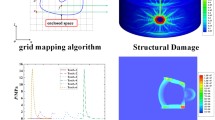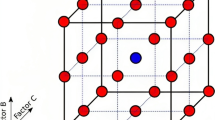Abstract
Ensuring the safe operation of large LNG storage tank projects under blast loads is very important. First, using LS-DYNA software, numerical simulations of air blast wave propagation are studied with the ALE algorithm and fluid-solid coupling theory. A new corrected formula for the peak overpressure is proposed based on the numerical results, and its accuracy is verified by comparing the numerical results with the empirical formula and test results. Then, a finite element model of a large LNG storage tank is built, assuming that the explosion source is located 10 m away from both the ground and the tank wall. This model is used to analyse the overpressure and dynamic response of the outer concrete tank and to predict the TNT equivalent quantity that the tank can withstand. The results show that the tank wall facing the burst loads is in a more dangerous state and that the principal tensile stress increases approximately linearly with increasing TNT equivalent quantity. When the TNT equivalent quantity reaches 2.5 t, concrete element failure occurs on the centre facing the explosions, and the outer tank structure is damaged. The conclusions can provide a reference for the blast-resistant design of large LNG storage tanks.
Similar content being viewed by others
References
Alderman, J. (2005). “Introduction to LNG safety.” Process Safety Progress, Vol. 24, No. 3, pp. 144–151, DOI: 10.1002/prs.10085.
Atkinson, G. (2011). “Blast damage to storage tanks and steel clad buildings.” Process Safety and Environmental Protection, Vol. 89, No. 6, pp. 382–390, DOI: 10.1016/j.psep.2011.06.020.
Baker, W. E. (1974). Explosions in Air, University of Texas Press, Austin, TX.
Barr, P. (1990). Guidelines for the Design and Assessment of Concrete Structures Subjected to Impact, United Kingdom Atomic Energy Authority, Zurich.
Bounds, W. L. (2010). Design of Blast-Resistant Buildings in Petrochemical Facilities, American Society of Civil Engineers.
Brode, H. L. (1959). “Blast wave from a spherical charge.” The Physics of Fluids, Vol. 2, No. 2, pp. 217–229, DOI: 10.1063/1.1705911.
BS EN 14620-1:2006 (2006). Design and manufacture of site built, vertical, cylindrical, flat-bottomed steel tanks for the storage of refrigerated, liquefied gases with operating temperatures between 0°C and -165°C. Institution B S.
Center for Chemical Process Safety (CCPS) (1994). Guidelines for evaluating the characteristics of vapor cloud explosions, Flash Fires, and BLEVEs, Wiley-AICHE, New York.
Cheng, S. (2008). The performance and design method study of prestressed concrete beam under impact load function, Master Dissertation, Nanjing University of Science & Technology, Nanjing, Jiangsu, China.
Cheng, X., Sun, L., Ma, H., Han, M., and Zhang, R. (2015). “Thermal stress and crack distribution of concrete dome of spherical LNG storage tank.” Journal of China University of Petroleum, Vol. 39, No. 5, pp. 130–136.
Dong, G. X., Du, M. H., and Huang, X. F. (2010). “Correction on parameters of calculation formula for shockwave overpressure peak value of one explosive.” Journal of Naval Aeronautical and Astronautical University, Vol. 25, No. 5, pp. 542–544.
Drake, J. and Frank, R. (1987). “A simplified method for the prediction of the ground shock loads on buried structures.” Symposium Proceedings from the Interaction of Conventional Munitions with Structures, Mannheim, pp. 3–14.
Drake, J. L. and Little Jr., C. D. (1983). “Ground shock from penetrating conventional weapons.” Symposium Proceedings from the Interaction of Non-Nuclear Munitions with Structures, Colorado, pp. 1–6.
Drake, J. L., Twisdale, L. A., Frank, R. A., Dass, W. C., Rochefort, M. A., Walker, R. E., Britt, J. R., Murphy, C. E., Slawson, T. R., and Sues, R. H. (1989). Protective construction design manual, Report Number ESL-TR-87-57, Air Force Engineering and Services Center, Florida.
Duan, H. (2012). “A leakage and explosion hazard analysis on dalian liquid natural gas station.” Journal of Chinese People's Armed Police Force Academy, Vol. 28, No. 4, pp. 36–38.
Foss, M. M. (2003). LNG Safety and Security, CEER0653841, The University of Texas at Austin, Sugar Land.
Gao, X. and Wu, Y. (2015). “Numerical calculation and influence parameters for TNT explosion.” Chinese Journal of Explosives and Propellants, Vol. 38, No. 3, pp. 32–39.
GB 50316–2000 (2008 edition) (2008). Design code for industrial metallic piping, National Standards of the People's Republic of China, China Planning Press, China.
General Administration of Quality Supervision (2014). Inspection and quarantine of the people's Republic of China, GB6722-2014 Safety Regulations for Blasting, China Standard Press, Beijing.
Gugan and Keith (1979). Unconfined vapour cloud explosions, Instituion of Chemical Engineers.
Guo, W., Yu, T., and Jin, P. (2007). “Test of triple point and study on its test technology.” Chinese Journal of Explosives and Propellants, Vol. 30, No. 4, pp. 55–57.
Hallquist, J. O. (2007). LS-DYNA keyword user’s manual, Version 971, Livermore Software Technology Corporation, Livermore, CA.
Henrych, J. (1979). The Dynamics of Explosion and Its Use, Elsevier, Amsterdam.
Li, Y. Q. and Ma, S. Z. (1992). Explosion Mechanics, Science Press, Beijing.
Lu, H. and Liu, W. (2009). “Research on numerical simulation of blast wave in air.” Journal of Wuhan University of Technology, Vol. 31, No. 19, pp. 105–108.
Oesterle, M. G. (2009). Blast Simulator Wall Tests: Experimental Methods and Mitigation Strategies for Reinforced Concrete and Concrete Masonry, Doctoral Thesis, University of California, San Diego.
Pan, X., Xu, J., and Jiang, J. (2008). “Simulation analysis of dynamic response of thin-wall cylindrical tank to shock wave.” Journal of Chemical Industry and Engineering (China), Vol. 59, No. 3, pp. 796–801.
Parfomak, P. W. and Vann, A. S. (2009). “Liquefied Natural Gas (LNG) import terminals: Siting, safety, and regulation.” RL32205, Washington D.C.: Congressional Research Service Reports, Vol. 4, No. 1.
Pietersen, C. M. (1988). “Analysis of the LPG-disaster in mexico city.” Journal of Hazardous Materials, Vol. 20, No. 1, pp. 85–107, DOI: 10.1016/0304-3894(88)87008-0.
Reid, R. A. (1995). Conventional Weapons Effects on Reinforced Soil Walls, Ph.D. Dissertation, Georgia Institute of Technology, Atlanta, GA.
Remennikov, A. M. (2003). “A review of methods for predicting bomb blast effects on buildings.” Journal of Battlefield Technology, Vol. 6, No. 3, pp. 1–7.
Sadovskyi, M. (1952). Mechanical Action of Air Shock Waves of Explosion, Based on Experimental Data, Izd Akad Nauk SSSR, Moscow, pp. 1–2.
Schneider, P., Buchar, F., and Zápeca, F. (1999). “Structural response to thin steel shell structures due to aircraft impact.” Journal of Loss Prevention in the Process Industries, Vol. 12, No. 4, pp. 325–329, DOI: 10.1016/S0950-4230(99)00005-4.
The eighth writing group of Beijing Institute of Technology (1979). Explosion and its role, National Defense Industry Press, Beijing.
Wang, J. L., Guo, W., and Feng, X. J. (2008). “Experimental research on the air explosion shock wave parameters of TNT, PBX and hexel.” Chinese Journal of Explosives and Propellants, Vol. 31, No. 6, pp. 42–44.
Wang, T. Y., Ren, H. Q., and Wang, Y. L. (2005). “Analysis of dynamical response of nuclear power plant concrete containment under contact blast load.” Nuclear Power Engineering, Vol. 26, No. 2, pp. 187–185.
Weng, D. and Ge, Q. (2014). “A dynamic response analysis of an extralarge LNG storage tank under blasting conditions.” Natural Gas Industry, Vol. 34, No. 1, pp. 139–145.
Wu, C. and Hao, H. (2005). “Modeling of simultaneous ground shock and airblast pressure on nearby structures from surface explosions.” International Journal of Impact Engineering, Vol. 31, No. 6, pp. 699–717, DOI: 10.1016/j.ijimpeng.2004.03.002.
Yang, X., Shi, S. Q., and Cheng, P. F. (2008). “Forecast and simulation of peak overpressure of TNT explosion shock wave in the air.” Blasting, Vol. 25, No. 1, pp. 15–19.
Zhang, R., Weng, D., and Ren, X. (2011). “Seismic analysis of a LNG storage tank isolated by a multiple friction pendulum system.” Earthquake Engineering and Engineering Vibration, Vol. 10, No. 2, pp. 253–262, DOI: 10.1007/s11803-011-0063-3.
Zhang, T., Hui, J. M., Xie, L. F., Guo, X. Y., and Yu, J. (2004). “Experimental research on the overpressure and power in the FAE blast field.” Explosion and Shock Waves, Vol. 24, No. 2, pp. 176–181.
Zhou, B. S., Zhang, L. H., Wang, S. L., Gao, H., and Hu, J. (2010). “Numerical simulation and experimental research on tnt explosion shock wave.” Journal of Projectiles, Rockets, Missiles and Guidance, Vol. 30, No. 3, pp. 88–90.
Author information
Authors and Affiliations
Corresponding author
Rights and permissions
About this article
Cite this article
Zhang, R., Jia, J., Wang, H. et al. Shock Response Analysis of a Large LNG Storage Tank Under Blast Loads. KSCE J Civ Eng 22, 3419–3429 (2018). https://doi.org/10.1007/s12205-017-1246-x
Received:
Revised:
Accepted:
Published:
Issue Date:
DOI: https://doi.org/10.1007/s12205-017-1246-x




